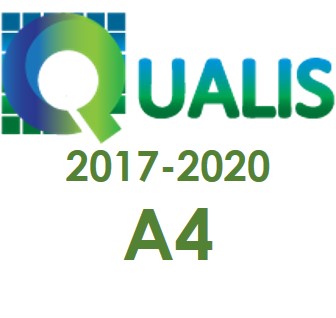Características da duração do ruído das fricativas de uma amostra do Português Brasileiro (Characteristics of the duration of the fricative noise of a sample of Brazilian Portuguese)
DOI:
https://doi.org/10.22481/el.v10i1.1167Palavras-chave:
Duração segmental, Fricativas, Português BrasileiroResumo
Nosso objetivo é descrever a duração do ruído fricativo em função da sonoridade, da posição que a fricativa ocupa dentro da palavra (onset ou coda, no início, no meio ou no final), do contexto vocálico que lhe é adjacente (próximas de /a/, /i/ e /u/) e do seu ponto de articulação (labiodentais, alveolares e palatoalveolares). Nossos resultados evidenciam que as fricativas surdas apresentam, categoricamente, a duração relativa maior que sua contraparte sonora. Além disso, indicam que a duração segmental também é um parámetro robusto para diferenciar as fricativas em relação à posição silábica, ao ponto de articulação e à qualidade vocálica adjacente.
PALAVRAS-CHAVE: Duração segmental. Fricativas. Português Brasileiro.
ABSTRACT
Our goal is to describe the duration of the fricative noise as a function of voicing, the position the fricative occupies in the word (onset or coda, in the beginning, middle or end), of the adjacent vowel context (near / a /, / i / and / u /) and its point of articulation (labiodentals, alveolars and postalveolares). Our results show that the voiceless fricatives have, categorically, the relative duration greater than its counterpart voiced. Furthermore, our results indicate that the segmental duration is also a robust parameter for differentiating the fricatives with respect to syllable position, the point of articulation and adjacent vowel quality.
KEYWORDS: Segmental duration. Fricatives. Brazilian Portuguese.
Downloads
Referências
DOCHERTY, G. J. The timing of voicing in British English obstruents. Berlin: Foris Publications, 1992. 289p.
HAUPT, C. As fricativas [s], [z], [S] e [Z] do português brasileiro. Estudos lingüísticos, Araraquara, v. XXXVI, n. 1, p. 37-46, 2007.
HOGAN, J. T.; A. J. ROZSYPAL. Evaluation of vowel duration as a cue for the voicing distinction in the following word-final consonant. Journal of the Acoustical Society of America, Nova York, v. 67, n. 5, p. 1764-1771, 1980.
JESUS, L. M. T. Acoustic Phonetics of European Portuguese Fricative Consonants. 2001. 249 f. Tese (Doutorado em Filosofia) - Department of Electronics and Computer Science of the University of Southampton, Southampton, 2001.
KENT, R. D.; READ, C. Acoustic analysis of speech. 2. ed. San Diego: Singular, 2002. 311 p.
KLATT, D. Linguistics use segmental duration in English: acoustical and perceptual evidence. Journal of the Acoustical Society of America, Nova York, n. 59, p. 1208-1221, 1976.
LISKER, L.; AMBRAMSON, A. A cross-languages study of voicing in initial stop. Word, Nova York, n. 20, p. 384-422, 1964.
PIRELLO, K.; S. E. BLUMSTEIN; K. KUROWSKI. The characteristics of voicing in syllable-initial fricatives in American English. Journal of the Acoustical Society of America, Nova York, v. 101, n. 6, p. 3754- 3765, 1997.
O’SHAUGHNESSY. D. Consonant durations in clusters. IEEE Transactions on Acoustics, Speech and Signal Processing, Piscataway, v. 22, n 4, p. 282-295, 1974.
SAMCZUK, I. B; GAMA-ROSSI, A. Descrição fonético-acústica das fricativas do português brasileiro. Intercâmbio, São Paulo, v. 13, p. 1-9, 2004.
SCHWARTZ, M. F. Influence of vowel environment upon the duration os /s/ and /S/. Journal of the Acoustical Society of America, Nova York, v. 46, n. 2, p. 480-481. 1969.
SHADLE, C. Phonetic, Acoustic. Encyclopedia of Language & Linguistics, New haven, Connecticut: Haskins Laboratories, 2. ed., v. 9, p. 442-460, 2006,
SHADLE, C. H; MAIR, S. J. The voiced/voiceless distinction in fricatives. In: Proceedings of The Institute of Acoustics Autumm Conference (Speech and Hearing 96), book 1, volume 18, part 9, Windermere, UK, p. 163-169, 1996.
SLIS, I. H.; COHEN, A. On the complex regulating the voiced - voiceless distinction II. Language and Speech, Thousand Oaks, v.12, n 3, p. 137-155, 1969.
STEVENS, K. N.; BLUMSTEIN, S. E.; GLICKSMAN, L.,; BURTON, M.; KUROWSKI, K. Acoustic and perceptual characteristics of voicing in fricatives and fricative clusters. Journal of the Acoustical Society of America. Nova York, v. 90, n. 5, p. 2979–3000, 1992.
Downloads
Publicado
Edição
Seção
Licença
Autores que publicam em Estudos da Língua(gem) concordam com os seguintes termos:
Estudos da Língua(gem) mantém os direitos autorais das contribuições publicadas e disponibiliza seu conteúdo gratuitamente por meio do portal. Autores têm permissão e são estimulados a publicar e distribuir seu trabalho online em repositórios institucionais ou na sua página pessoal, com reconhecimento de autoria e créditos de publicação inicial nesta revista, indicando endereço online.












